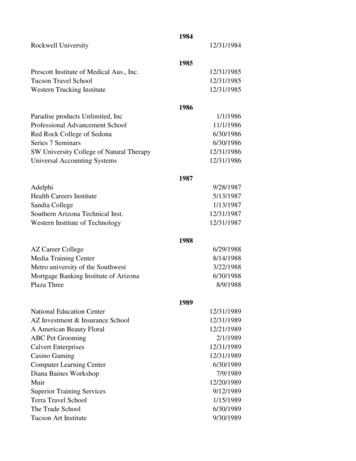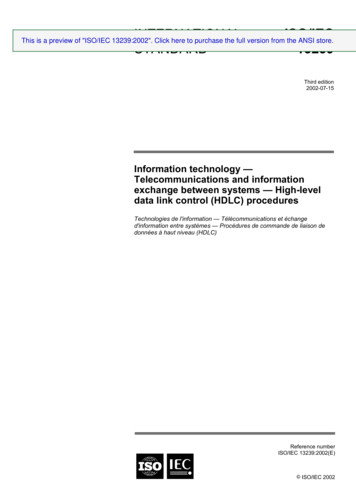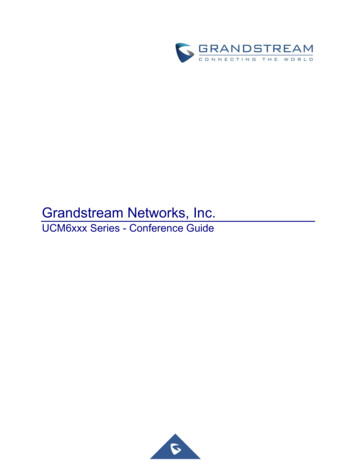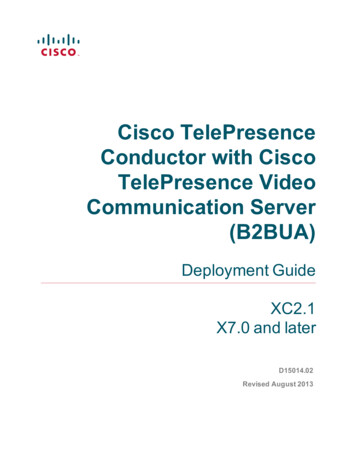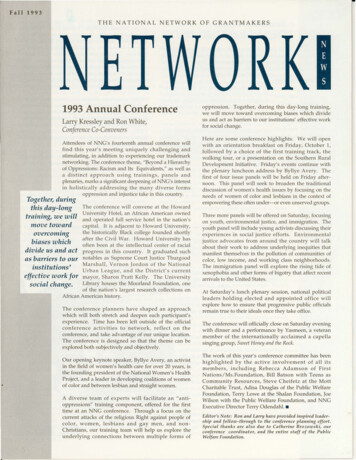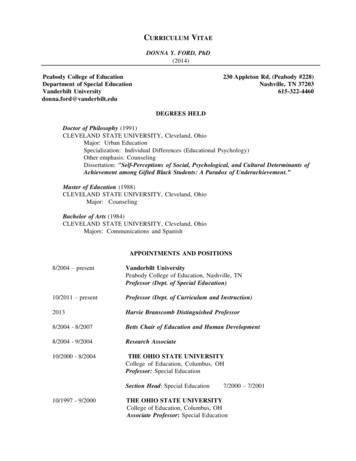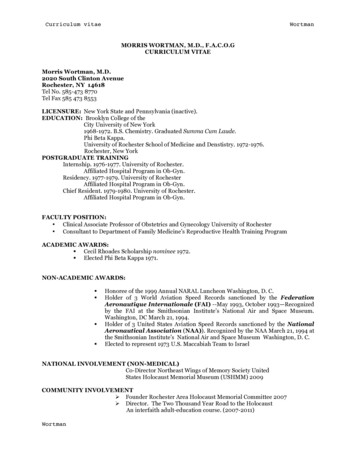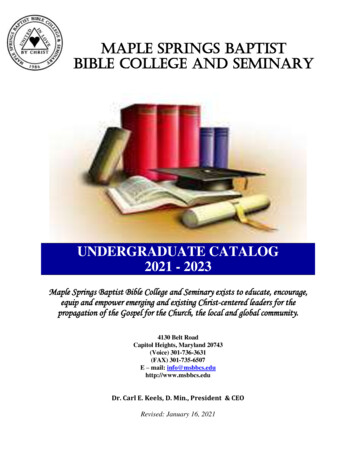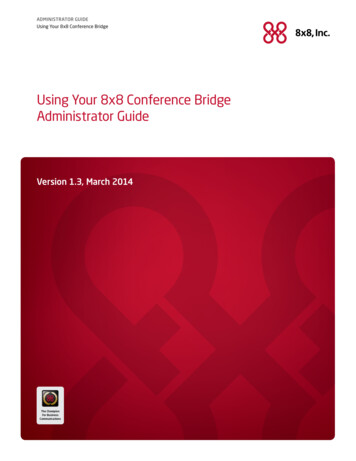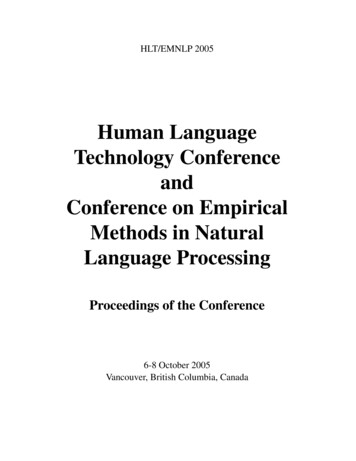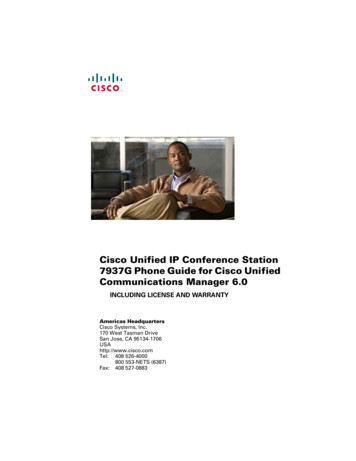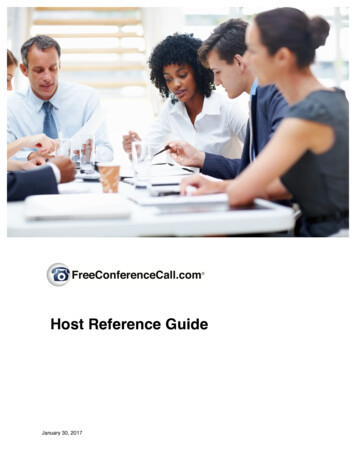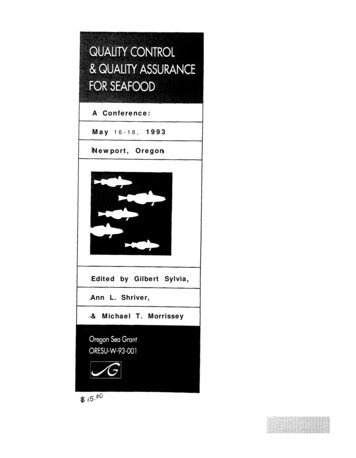
Transcription
A Conference:May 1 6 - 1 8 ,1993Newport, OregonEdited by Gilbert Sylvia,Ann L. Shriver,& Michael T. Morrissey
Oregon Sea Grant, Oregon State University,Administrative Services A402, Corvallis, Oregon 97331-2134 1994 by Oregon State University. All rights reserved.ISBN l-881826-08-2
Support viPreface viiAcknowledgments ixAbbreviations xContributors xiReport from the Office of Seafood: an Issues UpdateThomas J. Billy1NATIONAL AND INTERNATIONAL PERSPECTIVES ON SEAFOODQUALITYTrends In Seafood Quality Assurance 9Liz Brown and Gilbert SylviaImport Standards and Regulations for Seafood Sold in the EEC, andIn-Plant Quality Assurance 15Peter HowgateInternal Marketing of Quality and Marketing Orientation at theNational Level: Cooperation Between the Norwegian Governmentand the Industry 21Terje E. MartinussenEvolving International Inspection Standards and Impacts on U.S.Seafood Trade 31Thomas J. MoreauThe Canadian Quality Management Program35Ian DevlinFDA Inspection Programs for SeafoodRoger Lowell39The Use of Total Quality Product and Total Quality ManagementPrograms in Meeting New EEC Regulations 47Christian FelterQuality at General Mills RestaurantsRobert Joseph62The Need for Developing Uniform Surimi StandardsJae Park and Michael T. Morrissey64Implementing an IS0 9000 Quality System in a European SeafoodCompany Operating Internationally 72Sigurdur Bogason
IS0 9000-The Sealord Experience (Past Lessons and FutureVisions) 80Robert deBeerQuality Assurance Standards to Improve Market Opportunities forIQF Fillets and H&G Whiting 88Ron WilliamsIntegrating Quality Assurance into an Industry AssociationPanel/Audience Discussion 90Panel members: Sigurdur Bogason, Ian Devlin, Tom Libby,Terje Martinussen, Jim Ostergard, and Jay RasmussenSEAFOOD QUALITY ASSURANCE PROGRAMS: DESIGNIMPLEMENTATION AND MANAGERIAL STRATEGIESUsing TQM Principles to Implement HACCP 97Donald A. Corlett, Jr.Establishing Programs to Measure Quality Assurance104John ClemenceQuality Assurance: Internal and External OrganizationalRequirements 109Carmine GorgaMEASURING AND CONTROLLING SEAFOOD QUALITYHow Arctic Alaska Measures and Maintains Whiting/SeafoodQuality 117Allen KimballSensory Analysis Application to Harmonize Expert Assessors ofFish Products 120Terriann I. Rielly and Roberta K. YorkMeasuring and Controlling Seafood Quality in Japan125Etsuo WatanabeMeasuring the Quality of Seafood Products: Using Microcomputersand Statistical Process Control in the Seafood Industry 133Gregg J. SmallMaking Quality Pay: Strategies for Improving Seafood Quality onFishing Vessels 140Jim OstergardQUALITY ASSURANCE:MANAGEMENTCONCEPTS IN MARKETINGDevelopment of Quality in the Norwegian Fish-Farming IndustryFrom Quality Inspection to Quality Management 145Terje E. Martinusseniv
Demand for Seafood Quality Standards and Grades: The Case ofPacific Whiting Fillets 152Gilbert Sylvia, Michael Murphy, and Sherry LarkinQuality Assurance: Internal and External Financing Opportunities158Carmine GorgaTillamook: the Quality Tradition 164Harold SchildThe Quest for Quality: New Frontiers in Seafood MarketingPat Shanahan166
A number of agencies and individuals have supported research inPacific whiting fisheries aver the years. Among them are the followingUSDA/CSRS--Special Research Grant Agreement 92-34 276-7140Oregon State University Agricultural Experiment StationOregon Sea GrantNational Marine Fisheries ServiceCenter for Applied Agricultural ResearchOregon Trawl CommissionOregon Department af AgricultureCaptain Barry FisherThis book is funded by the National Oceanicand Atmospheric Administration, throughOregon Sea Grant (grant number NA89AA-DSG108). The views expressed herein are thoseof the authors and do not necessarily reflectthe views of NOAA or any of its subagencies.PUBLICATION CREDITSTechnical Editor: Sandy RidlingtonCover: Amy Charronvi
Controlling and improving seafood quality isone of the foremost challenges confronting themajority of the stock was harvested by foreignand joint-venture vessels delivering to processworld' s seafood industries. Seafoods can being ships from Europe and Asia. Domestic useconsidered delicate and highly perishableof whiting grew from 20,000 metric tons (mt)"commodities" like other foods, but many - in 1990 to over 200,000 mt in 1991 because ofplex quality issues result from conditionsincreased prices for various product forms andunique to this industry. For example, mostan expanding west coast fishing and processeafoods aren’t raised under controlled condiing fleet. Pacific whiting, with potential allow tions from a few cultivated breeds, but areable biological harvests of 200,000 to 500,000hunted and captured from thousands of pubmt, is now considered “fully utilized.” The 1992licly managed wild stocks and species. Theseseason showed a dramatic increase in shoreconditions complicate efforts to standardizebased investment in processing facilities; it isproduct quality, particularly in comparison t oestimated that 75,000 to 100,000 mt of PacificCompeting industries that use animal huswhiting will be processed shoreside in 1994bandry techniques (including aquaculture).(the remaining 140,000 mt will be processed aCommercially harvested seafoods are also cap- at sea).tured at long distances from processing andThis rapid transformation to domestic prodistribution centers. Variability in supply andcessing has compounded difficulties in underquality due to natural variation in these wildstanding and controlling the quality attributescreatures, and problems arising from publicthat critically affect the value of whiting prodmanagement of the resource, complicate qualucts. A better understanding of the inherentity problems. The risk and uncertainty associcharacteristics of Pacific whiting and how theyated with this variability often make itaffect final product quality and market develunprofitable to invest in the capital and huopment is crucial for the development of a susman resources necessary to improve producttainable, profitable industry.quality. Providing products that consistentlyGiven the size of the resource and its prodsatisfy consumer demand and enhance market uct quality problems, a considerable amount ofopportunities is therefore a difficult and daunt private and public effort has been expended toing task for many sectors of the industry.understand biological, technical, and marketing problems. Conferences on Pacific whitingMany of the firms that process productsfrom the assemblage of codlike fish known aswere held in Astoria, Oregon, in 1990 andhakes and whitings are particularly vulnerable again in Newport in 1992. In late 1992, Oregonto these problems. Although these species arefishers and seafood processors joined togetherto form the Pacific Northwest Seafood Associaspread across every major ocean and have diverse life histories, they share two intrinsiction (PNSA). One of the primary objectives ofcharacteristics that significantly affect finalthe association was to establish guidelines forcontrolling and improving Pacific whiting qualproduct quality: a relatively soft flesh and infestation of parasites, including myxosporidean ity. Association members recognized that therewere a number of organizations, seafood marparasites. These parasites are not only unketing associations, and government agenciessightly, but are often associated with high levthat had established seafood quality stanels of protease enzymes. These enzymes candards. They also understood that “official” proresult in a soft texture and contribute tograms such as HACCP, IS0 9000, and TQMbruised or mushy flesh, rapid rancidity, andreduced shelf life.were being proposed for implementation atgional, national, and international levels. TheAmong all species of hakes and whitings,none may be characterized by a greater combi- association believed that it would be beneficialnato learn from the individuals, firms, industrytion of preharvest product quality problemsgroups, and regional or national governmentsthan Pacific whiting (Merluccius productus),thathad spent years wrestling with the probfound off the west coast of the United Stateslemofmanaging seafood quality.The PNSAand Canada. Until recently, poor final productthereforeasked the organizers to plan a conferquality resulted, and market prices were tooencethatwould gather U.S.and internationallow to generate profits. Prior to 1991, the vastvii
experts to share their experiences and knowledge, in order to guide the Pacific whiting industry in developing its own successful qualityassurance programs.The conference was designed to cover arange of topics and to highlight the relationships between production, marketing, andquality management strategies. Topics coveredwere (1) the status and evolution of nationaland international seafood quality standards,(2) the “buyer’s” perspective on quality assurance, (3) seafood associations and the role ofquality standards, (4) measuring and controlling seafood quality, (5) designing and managing quality assurance programs, and (6)quality assurance as a tool in marketing management programs.As conference organizers, we were extremely pleased by the quality of the speakersand their active participation in round tablediscussions as well as question and answersessions. We were also gratified to see the com-mitment to seafood quality demonstrated bymany of our colleagues, including fishers, processors, marketers, and researchers. We feltfortunate to have so many experts from regional, national, and international arenas whocould provide us with insights from their experience and research.VIIIOne of the missions of both Oregon StateUniversity’s Coastal Oregon Experiment Station and the International Institute of Fisheries Economics and Trade is to transferinformation on managing marine resourcesand marine resource-based industries to thepublic and private sectors where it can beused. We feel that this conference and its proceedings serve this purpose and provide theindustry with some unique insights into quality control and quality assurance programs forseafood.Gilbert SylviaMarine Resource EconomistCoastal Oregon Marine Experiment StationOregon State UniversityAnn L. ShriverExecutive DirectorInternational Institute for Fisheries Economicand TradeOregon State UniversityMichael T. MorrisseyDirector of the Astoria Seafood LaboratoryCoastal Oregon Marine Experiment StationOregon State University
(Oregon Trawl Commission). A special thanksto Susan Mills and Maureen Collson (CoastalOregon Marine Experiment Station), NancyChamberlain (OSU Seafood Laboratory), andGeorgia York (Oregon Coastal Zone Management Association) for helping in conference organization and overseeing the myriad detailsthat collectively make the difference betweensuccess and failure. Graduate studentsMichael Murphy, Maurice McCarthy, LizBrown, Finley Anderson, Greg Peters, andSherry Larkin did yeomen’s work transportingspeakers and editing various conference sessions. A round of applause from the editorsgoes out to Sandy Ridlington who edited themanuscripts and who took on the responsibilSeafood Laboratory, the Oregon Trawl Com- ity of getting the proceedings to print. We alsothank Bob Malouf, Director of Oregon Seamission, Pacificorp, and the U.S. DepartmentGrant, for financial support for th e publication.of Agriculture.Finally, a heartfelt thanks to Lavern Weber,We would especially like to thank those individuals who contributed significant amounts who, as Director of the Coastal Oregon MarineExperiment Station, has engendered amongof time and effort in support of the conference.his researchers a strong sense of responsibilityThey include Jay Rasmussen (Oregon Coastalforcommunicating and working with theZone Management Association), Tom Libbeycoastalcommunity to effectively address(Pt. Adams Packing Co.), Mark Coopercoastalconcerns.(Midwater Trawlers Cooperative), BarryFisher (Yankee Fisheries), and Joe EasleySeveral organizations, government agencies,and individuals made significant contributionsto the success of the conference and the publication of the proceedings. The Pacific Northwest Seafood Association and the OregonEconomic Development Department (as part ofits Key Industries Program) were the primaryconference sponsors. We would like to thankthe other contributors, which included the International Institute of Fisheries Economicsand Trade, the National Security Bank, theOregon Coastal Zone Management Association, the Oregon Department of Agriculture,the Oregon Sea Grant Program, Oregon StateUniversity's Coastal Oregon Marine Experiment Station, the Oregon State University
AFAQ-Association Francaise pourl’Assurance Qualite (the French QualityAssurance Association)ANSI-American National Standards InstituteAOC-Appellation d’Origine Controlee (specified origin label, France)ASMI-Alaska Seafood Marketing InstituteASP-amnesic shellfish poisonASQC-American Society for Quality ControlATP-adenosine triphosphateCAC-Codex Alimentarius CommissionCCP-critical control pointCFR-Code of Federal RegulationsCP-control pointDFO-Department of Fisheries and Oceans(Canada)DSP-Division of Seafood Programs (OS)EC-European CommunityEEC-European Economic CommunityESOP--employee stock ownership planFAO-Food and Agriculture Organization(UN)FD&C-Food Drug and Cosmetic Act of 1938(U.S.)FDA-Food and Drug Administration (U.S.HHS)FSIS-Food Safety and Inspection Services(USDA)FTA-Free Trade Agreement (U.S.-Canada)FWS-Fish and Wildlife Service (U.S.)GATT--General Agreement on Tariffs andTradeGMP-good manufacturing practiceHACCP-hazard analysis and critical controlpointsHHS-Department of Health and HumanServices (U.S.)IQF-individually quick frozenISO-International Standards OrganizationMF-Ministry of Fisheries (Norway)MOU-memorandum of understandingMSSP-Model Seafood Surveillance Program(NOAA)NACMCF-National Advisory CommitteeMicrobiological Criteria for FoodsNAS-National Academy of Science (U.S.)NFFSO-Norwegian Fish Farmers’ SalesOrganizationNFI-National Fisheries Institute (U.S.)NMFS-National Marine Fisheries Service(U.S.)NOAA-National Oceanic and AtmosphericAdministration (U.S.)NSIP-National Seafood Inspection Program(U.S.)OIE-Office of Epizootics-health and sanitary requirements for the import andexport of animals (U.S.)OS-Office of Seafood (U.S.-FDA)PC-production capacityPO-producer organizationsPSP-paralytic shellfish poisonPUFI-packed under federal inspectionP-productionQA-quality assuranceQMP-Quality Management Program(Canada)RAB-Registrar Accreditation BoardRNE-Reseau National d’Essais (NationalTesting Network, France)SIFE-Sanitarily Inspected Fish EstablishmentSPC-statistical process controlSTP-sodium tripolyphosphateTQM-total quality managementTRQ-Tariff Rate QuotaUN-United NationsUSDA-U.S. Department of AgricultureUSDC-U.S. Department of CommerceWHO-World Health Organization
Thomas J. BillyDirector, Office of SeafoodFood and Drug Administration1110 Vermont Avenue, N.W.Washington, D.C. 20005USASigurdur BogasonDevelopment & Quality ManagerIcelandic Freezing Plant Corp.Adalstraeti 6101 ReykjavikICELANDLiz BrownCollege of Oceanic and Atmospheric SciencesOregon State UniversityOcn. Admin. Bld., Rm 104Corvallis, OR 97331-5503USAJohn ClemenceSeafood SpecialistPharmaceutical & Food Specialities10604 Forest Ave.Seattle, WA 98178USADonald A. Corlett, Jr.Corlett Food Consulting Service5745 Amaranth PlaceConcord, CA 94521USARobert deBeerQuality Systems ManagerSealord ProductsPO Box 11NelsonNEW ZEALANDIan DevlinChief of Facilities & Offshore InspectorDept. of Fisheries and Oceans2250 S. Boundary Rd.Burnaby British Columbia V9M 4L9CANADAChristian FelterConsulting Agricultural and Food Engineer58 rue DroitNice FRANCECarmine GorgaPresident, Polisetics87 Middle StreetGloucester, MA 01930USAPeter HowgateSeafood Processing Consultant3 Kirk Brae, CultsAberdeen AB1 98RScotlandRobert JosephDirector, Seafood ProcurementRed LobsterGeneral Mills RestaurantsPO Box 59330Orlando, FL 32859-3330USAAlan KimballOperations DirectorArctic AlaskaPier 91, Bldg 392Box C119Seattle, WA 98119USASherry LarkinDepartment of Agricultural and REsourceEconomicsOregon State UniversityBallard Hall, Rm. 322Corvallis, OR 97331-3601USARoger LowellDistrict DirectorUSFDAPO Box 3012Bothel, WA 98041USATerje E. MartinussenSenior ResearcherFiskeriforskningPO Box 2511N-9002 TromsoNORWAY
Thomas J. MoreauDirector, Inspection Services Div.National Marine Fisheries Service1 Blackburn DriveNMFS-GloucesterGloucester, MA 01930USAMichael T. MorrisseyDirector, Astoria Seafood Lab250 36th StreetAstoria, OR 97103USAMichael MurphyCollege of Oceanic and Atmospheric SciencesOregon State UniversityOcn. Admin .Bld. , Rm 104Corvallis, OR 97331-5503USAJi m OstergardPeregrinator Marine ServicesNew England Fisheries Dev.309 World Trade CenterBoston, MA 02210USAJae ParkFood TechnologistAstoria Seafood Lab250 36th StreetAstoria, OR 97103USATerriann I. ReillyFood Technologist1 Blackburn DriveNMFS-GloucesterGloucester, MA 01930USAHarold SchildGeneral ManagerTillamook County Creamery Assoc.PO Box 913Tillamook, OR 97141USAxiiPat ShanahanVice PresidentMcKnight and Company, Inc.1507 Western Ave. Suite 507Seattle, WA 98109USAGregg J. SmallDirector of Technical ServicesGolden Age Fisheries18 Mercer Street Suite 400Seattle, WA 98119USAGilbert SylviaAssistant ProfessorHatfield Marine Science CenterNewport, OR 97365USAEtsuo WatanabeProfessorDept. of Food Science & TechnologyTokyo Univ. of FisheriesA-5-7, Kohnan, Minato-kuTokyo 108JAPANRon WilliamsShore Trading Co., Inc.145 Norcross StreetRoswell, GA 30075USARoberta K YorkDepartment of Fisheries and OceansCentral and Arctic RegionFreshwater Institute501 University CrescentWinnipeg, Manitoba R3T 2N6CANADA
Thomas J. BillyOffice of Seafood, Center for Food Safety and Applied Nutrition,U.S. Food and Drug AdministrationIt is not that the public expects assurancethatfood is absolutely safe. But it does expectIn the United States, consumers eat aboutthatasystem is in place to ensure that food is1,000 commercial species and spend about 30assafeas we can possibly make it-a systembillion annually on seafood. Every year thethatisresponsiveto today’s realities, today’sU.S. exports approximately 3 billion of itsrisks,andtoday’sconsumer expectations.harvest and imports approximately 200,000Seafood,likemanyother foods, poses a wideseafood entries from 135 countries, wortharrayofpotentialhealthproblems, most ofabout 5 billion.whichneveroccur.Dataindicatethat the rateNutritionally, seafood contributes to aofillnessfromseafoodisextremelylow and on ,healthful diet as a source of high-quality proaperpoundconsumedbasis,isdeclining.tein, certain vitamins and minerals, and essenSome problems, however, do arise becausetial fatty acids. Consumers have come toofpathogenicbacteria and viruses: natural toxdepend on seafood as a protein source in theirins,likedomoicacid along the Oregon coast;quest for low-fat, low-cholesterol diets: conchemicalcontaminants;parasites; decomposisumption has increased in the last decade totion;anddrugresidues.almost 15 pounds a person. It is evident, then,The changing conditions and increasingthat seafood is an important commodity in thetechnologicaladvances in the seafood industryU.S. diet and a significant contributor to thearetypifiedbythe areas of aquaculture ,engiGNP and world trade.neered seafood (surimi) ,and vacuum andmodified atmospheric packaging. TheseOFFICE OF SEAFOODchanges and resultant demands are not uniqueThe Food and Drug Administration’s (FDA)to the seafood industry. The fundamental waysOffice of Seafood is a little over two years oldin how we produce, distribute, and consumeand in that brief period has accomplishedfood have changed since the basic elements ofmuch that will serve as the springboard to im- today ’s food safety system were put in place.proving and assuring the safety of seafood.The Office of Seafood is in the forefronttof FDAIn remarks at the March 22,1993 Nationalefforts to respond to these new issues and chalFood Policy Conference, David Kessler, Comlenges , which it sees not as obstacles, but asmissioner of Food and Drugs, said that if weopportunities.food regulators are going to ensure the safetyand wholesomeness of the U.S. food supply, we STRATEGIC PLAN FY 93-98can ’t do the job the same way we were doing itThe Office of Seafood has recognized that25 - or- even 10 - years ago. We cannot affordconductinginspections, gathering samples,to march in place.andrunninglaboratory analyses and researchWe need to recognize that the food industrywerenotsufficienttto protect the consumerand consumption patterns have changed drafromallpotentialhazards.This recognitionmatically. The Pacific whiting surimi industryhasresultedinadifferentperspectiveon seais a good example.food safety. The new perspective is reflected ina draft strategic plan that is in its final formaFDA SEAFOOD PROGRAMtive stages and that will reflect suggestionsIn the face of these changes in the producfrom the industry, state and local agencies, ,scition and consumption of food, consumers conentists , and consumers. Our intention withtinue to ask the same two simple andthis plan is to create complete consumer confilegitimate questions: “Is the food safe to eat?” dence in all seafood.and “What are you doing to make it safe?”The strategic plan set s four strategic g o a l sThey are to ensure the following:GLOBAL PIC1(
that seafood products are safethat seafood is wholesome and properlylabeledthat the FDA, industry, and consumershave accurate information concerningseafoodthat the infrastructure exists to accomplish 1,2, and 3 aboveWe are achieving these goals, as I willshow, through specific activities and new initiatives in the seafood arena.ECONOMIC FRAUDEconomic fraud is of sufficient complexitythat it can occur even among members of theseafood industry who are most knowledgeableabout the products and trade practices. Thisproblem has been targeted as a major concernby Commissioner Kessler, who has been applauded by the industry for his efforts. First,the FDA’s budget for work in this area hasbeen doubled. Second, over 1,000 letters havebeen sent to the industry warning againstoverglazing. Third, a number of actions havebeen taken against species substitution, including Pacific rockfish substituted for redsnapper, pollock for cod, oreo dory for orangeroughy, and some freshwater species for saltwater species. The FDA has been much moreactive in this area over the past two years, andit intends to continue to vigorously pursue action against these and other types of economicfraud.SCALLOPS AND PHOSPHATESFresh sea scallops are 75 to 79 percent water. They may lose considerable moisture aftershucking; however, this loss may be preventedby treatment with sodium tripolyphosphate(STP). There is even some indication that STPmay help preserve desirable eating characteristics.However, it turns out that prolonged soaking of scallops in STP solutions results in thescallops' taking up excess water. And unfortunately, some scallop processors have been taking advantage of this to enhance productweight and their profits. Selling this excesswater at the price of scallops constitutes economic fraud.LABELING POLICYAfter some people in industry expressedtheir frustration and concern to the FDA, we2responded by setting an interim labeling policyfor scallops based on water content. This policywas designed to ensure fair play within theindustry and a fair product for the consumer,Specifically, the policy is that scallops thathave been treated with STP and have pickedup water must be labeled with the identitystatement, “X percent of water-added scallopproduct.” This labeling must be used with anyscallop with 80 to 84 percent water. In addition, the statement “Processed with SodiumTripolyphosphate” or any other phosphatethat might be used must appear on the label;and the phosphate(s) and added water must bein the ingredients statement. No scallops containing greater than 84 percent water will beallowed on the market.In other words, untreated scallops with 79percent water or less are to be labeled “scallops.” Any product with 80 to 84 percent moisture should be labeled as scallop product, andanything over 84 percent moisture cannot bemarketed.This policy will remain in effect until theagency completes an evaluation of the additional data recently provided by industry. Thedata concern the relationship between the normal moisture content of freshly shucked scallops and their treatment, as well as thepossible loss of key nutrients.PROBLEMS WITH CRABBlue CrabIt has been FDA policy for decades thatproduct labeled “crab meat,” with no qualifications, must be derived from the blue crab.There have been some complaints from theblue crab industry, however, that imported,less valuable crab meat from other species isbeing substituted for blue crab and labeled as“crab meat,” with no regard for our policy andrequirements. In addition, some companiesare ignoring the U.S. Customs Service’s labeling requirement for country of origin. We areworking closely with the U.S. Customs Serviceand other agencies on this problem. One firmhas already been prosecuted for this illegalpractice in the State of Maryland.Dungeness CrabThe west coast has certainly had more thanits share of problems in the last few years withdomoic acid and the saxitoxins, associatedwith amnesic shellfish poison (ASP) and paralytic shellfish poison (PSP), found in the vis-
cera of Dungeness crab. Again, the FDA hasestablished a policy and is taking actionagainst crabs found to have 30 or more partsper million (ppm) domoic acid in the viscera; or80 or more micrograms per 100 grams saxitoxin in the viscera. This 30 ppm is a recentrevision upward from a previous level of 20ppm, based upon new data provided to ourHealth Hazards Evaluation Board. These toxins also have affected the harvest of west coastrazor clams. PSP in razor clams must be below80 micrograms per 100 grams; domoic acidmust be below 20 ppm, or the beds are closedto harvest.CONTAMINANTSChemical ContaminantsThe presence of chemical contaminants inseafood-both marine and freshwater species - is often a regional issue. The FDA’s roleis to determine allowable levels for productsentering interstate commerce. Because we recognize that regional concerns may not be effectively addressed by national controls, we havebeen working on guidance documents that local health authorities can use to issue advisories or close areas to both commercial andrecreational fisheries.Contaminant Limits for ShellfishFour of these guidance documents havebeen issued for contaminants of shellfish (including molluscan and crustacean shellfish).The contaminants are arsenic, nickel, chromium, and cadmium. Documents for other contaminants are under development and,following review by a subcommittee of the Association of Food and Drug Officials, will beissued.National ConferenceIn April 1993, the FDA hosted a two-dayconference in Washington, D.C., on chemicalcontaminants in seafood. The purpose was todraw together state regulatory agencies, industry, scientists, other federal agencies, and interested consumer groups to share informationon current and planned efforts to assess therisk of chemical contaminants in seafood. Participants also discussed how to manage theserisks and how to go about communicating tothe world what the risks really are. Our meeting was hailed as a new paradigm in risk communication. This meeting will go a long way inhelping us in FDA to focus our resources.Color AdditivesWhen canthaxanthin was approved for coloring food directly and through chicken feed, itwas not the agency’s intent to permit its use asan additive to fish feed, although we did notexplicitly prohibit it. This ambiguity has led tosome confusion in the aquaculture industryand in the agency.Petitions for the use of canthaxanthin andastaxanthin are in varying stages of submission and review, These and other color additives may be present in fish products, andregardless of whether they are added directlyor through the fish feed, or whether they are ofnatural or synthetic origins, they are artificialcolors and any labeling must state that colorhas been added.The problem with Listeria in seafood remains difficult Our current policy is that if wedetect it, we take action. The focus here is withready-to-eat products such as smoked fish andsurimi that will not be cooked sufficiently bythe consumer.As a follow-up to limited inspections of virtually the entire domestic seafood processingindustry completed over a year ago, we haveconducted more in-depth inspections of producers ofready-to-eat productsproducts in modified atmospherepackaging3) products from scombrotoxic species,such as tuna, mahi mahi, and amberjack4) some specialty products likely to havehigh microbial loads1)2)These inspection surveys have been a greathelp in providing us with an overview and understanding of the latest industry practicesand in targeting for future activities.Firms processing these types of products,often referred to as “high-risk” products, arenow inspected on an annual basis.HACCP INITIATIVEI mentioned earlier that both the food industry and consumption patterns have changeddrastically in the last decade. The Americanconsumer relies now on foods produced in hightech, centralized processing facilities, shipped
over long distances, and packaged and storedin new ways. For a number of reasons, the opportunities for food-borne illness have increased. The consumption of prepared foodssold ready-to-eat at retail outlets is expandingrapidly. There are more steps between the harvest site and the kitchen table, more steps inprocessing, and greater distances of transport.As a result, there is more opportunity for foodto be contaminated. Furthermore, new pathogens have appeared, there has been an increase in the incidence of industrial chemicalsand environmental contaminants, and certainhuman subpopulations are now at higher riskt
Oregon Coastal Zone Management Associa-tion, the Oregon Department of Agriculture, the Oregon Sea Grant Program, Oregon State University's Coastal Oregon Marine Experi-ment Station, the Oregon State University Seafood Laboratory, the Oregon Trawl Com-mission, Pacificorp, and the U.S. Department of Agriculture. We would especially like to thank .
